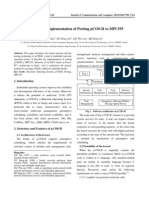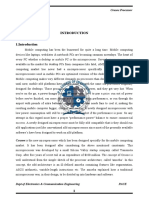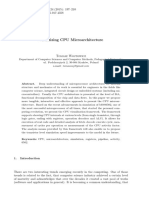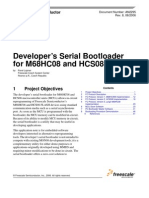0 ratings0% found this document useful (0 votes)
15 viewsThe Porting of Real-Time Operating System uC/OS-II On MCS-51 Series of MCU
The Porting of Real-Time Operating System uC/OS-II On MCS-51 Series of MCU
Uploaded by
pramani90fg
Copyright:
Attribution Non-Commercial (BY-NC)
Available Formats
Download as PDF, TXT or read online from Scribd
The Porting of Real-Time Operating System uC/OS-II On MCS-51 Series of MCU
The Porting of Real-Time Operating System uC/OS-II On MCS-51 Series of MCU
Uploaded by
pramani900 ratings0% found this document useful (0 votes)
15 views3 pagesfg
Original Title
Porting
Copyright
© Attribution Non-Commercial (BY-NC)
Available Formats
PDF, TXT or read online from Scribd
Share this document
Did you find this document useful?
Is this content inappropriate?
fg
Copyright:
Attribution Non-Commercial (BY-NC)
Available Formats
Download as PDF, TXT or read online from Scribd
Download as pdf or txt
0 ratings0% found this document useful (0 votes)
15 views3 pagesThe Porting of Real-Time Operating System uC/OS-II On MCS-51 Series of MCU
The Porting of Real-Time Operating System uC/OS-II On MCS-51 Series of MCU
Uploaded by
pramani90fg
Copyright:
Attribution Non-Commercial (BY-NC)
Available Formats
Download as PDF, TXT or read online from Scribd
Download as pdf or txt
You are on page 1of 3
The Porting of Real-Time Operating System uC/OS-II
on MCS-51 Series of MCU
Lin Shaofen, Zeng Shengbin
School of Marine Engineering, Jimei University
Xiamen, China
shaofenlin@163.com
zengshb@163.com
Jiang Xiaoxia
School of Marine Engineering, Jimei University
Xiamen, China
xmjiangxx@tom.com
AbstractThe powerful C/OS-II is based on the priority
preemptive real-time kernel which simultaneously provides
task management, time management, memory management
and communication between the tasks and functions can be
ported and reduced freely. This paper analyzes the structure
of C/OS-IIs kernel and its code, and introduces how to
porting C/OS-II to MCS-51 Series of MCU by means of
establishing working stack, simulation stack, task stack and so
on. At last, a test program is provided to prove the success of
the porting.
Keywords-real time; embedded operating system; C/OS-II;
porting
I. INTRODUCTION
With the increasing complexity of embedded computer
systems and the need of real-time multi-tasks, more and
more customers choose real-time operating system (RTOS).
Unlike most commercial RTOS comparison, the source
code resources of C/OS-II real-time operating system are
opened to the public. Most of the codes are written with
standard ANSI C and the procedures have strong
readability and portability which has been certificated and
passed the rigorous test by Federal Aviation
Administration[1]. More importantly, the refined core of the
C/OS-II real-time operating system is an effective control
system to overcome the shortage of hardware resources [2].
As a result, it is of great significance to research the
development and application of transplantation of C/OS-II
in a variety of embedded systems.
In recent years, the hot research point of real-time
embedded operating system is Linux, VxWorks WinCE
and so on, but they take up more memory hardware
resources [3]. MCU widely used in a variety of real-time
process control systems, such as industrial process control,
process monitoring, aerospace, weapons robotic systems and
other real-time control system. Processing and controlling
real-time data with MCS systems to ensure that the work in
the best condition, can improve the efficiency and product
quality of the system [4]. Due to limited hardware resources,
the device such as MCS-51 STC89C516RD+ porting, which
takes a high Cost-effective and is rapidly developed in
recent years, is more appropriate to C / OS-II real-time
operating system.
II. THE PORTING REQUIREMENTS OF UC/OS-II
A processor can run C/OS-II if it satisfies the
following general requirements:
1) Having a C compiler for the processor and the C
compiler must be able to produce reentrant code.
2) Be able to disable and enable interrupts from C.
3) The processor must support interrupts and you need to
provide an interrupt that occurs at regular intervals
(typically between 10 to 100 Hz).
4) The processor must support a hardware stack, and the
processor must be able to store a fair amount of data
on the stack (possibly many Kbytes).
5) The processor must have instructions to load and store
the stack pointer and other CPU registers either on the
stack or in memory.
The structured design of C/OS-II facilitates the
separation of related codes from the processor. As shown in
Figure 1, it is shows C/OS-IIs architecture and its
relationship with the hardware.
Software system can be divided into 4 parts, the related
code to processor OS_CPU.H, OS_CPU_A.ASM,
OS_CPU_C.C
III. THE PORTING METHOD OF UC/OS-II
Designing according to the characteristics of task stack,
the kernels combine application system and the underlying
hardware into a real-time system; it requires an intermediate
layer between the kernels and hardware, for the same kernel
can be applied to different hardware system, and this is
codes relate to the processor [5].
A. Compile OS-CPU.H
Includes the definition of related constants, macro, and
type to processor, such as # define. Specifically, the
definition of the type of systematic data, the definition of
growth direction of the stack, the definition of close and
open disruption, and the definition of interruption of the
soft systems and so on.
#define OS_ENTER_CRITICAL () EA = 0;
#define OS_EXIT_CRITICAL () EA = 1;
2009 International Conference on Measuring Technology and Mechatronics Automation
978-0-7695-3583-8/09 $25.00 2009 IEEE
DOI 10.1109/ICMTMA.2009.615
418
EA = 0 disable interrupts; EA = 1 close interruptions.
To make the definition of the procedure reduces the number
of rows, and avoid the computer crashes from closing
interruption after reset critical-zone. MCS-51 stack bottom-
up growth (1 = down, up = 0) shown in Figure 2,
OS_STK_GROWTH should be defined as 0.
-d`u OST/SlS" ) OSCtxS )
Because MCS-51 has no interruption of soft commands,
to calling the procedure. The two formats have the same
stack, RETI instruction interruption reset the system, RET
do not. For MCS-51, return stack must call for subroutines,
interrupted by the return of the RETI instruction stack is
possible, on the other hand, interrupt stack RET is not
feasible. In short, for stack, the effect of subroutine calls
and interruption calls are the same, you can use both of
them. In the absence of suspended event, resetting the
system interruption would not affect the normal operation
of the system.
B. Compile OS-CPU-C.C
The C / OS-II definite 10 functions in the document.
But the most important is task stack initialization function
OSTaskStkInit (). Others are used to expand the kernel of
the system.
OSTaskStkInit () is the call of system itself, when
establishes the task for the application of the tasks to
initialize the stack. So that the established stack which is
already, now to break the system can keep the same stack
structure with its environment variables when they finished
the storage. This interruption can be ready to return order to
make the task of running together. According to the internal
structure of MCS-51 stack and the production method, to get
the definition to OSTaskStkInit ().
C. Compile OS-CPU-A.ASM
The key to port C/OS-II is to rewrite 4 functions
OSStartHighRdy (), OSCtxSw (), OSIntCtxSw (),
OSTickISR ().
ACC
B
DPH
DPL
PSW
R0
R1
R2
R3
R4
R5
R6
R7
HIGH MEMORY
LOW MEMORY
Stack
Growth
Figure 2. MCS-51 Stack frame
Application Software
Software
Hardware
C/OS-II
(Processor Independent Code)
OS_CORE.C OS_FLAG.C
OS_MBOX.C OS_MEM.C
OS_MUTEX.C OS_Q.C
OS_SEM.C OS_TASK.C
OS_TIME.C uCOS_II.C
uCOS_II.H
C/OS-II Configuration
(Application Specific)
OS_CFG.H
INCLUDES.H
C/OS-II Port (Processor Specific Code)
OS_CPU.H OS_CPU_A.ASM OS_CPU_C.C
CPU Timer
Figure !. +C/OS-II Hardware/Software Architecture
419
1) OSStartHi-ghRdy () This function is called by
OSStart () to start the highest priority task ready-to-run.
2) OSCtxSw () The sequence of events that leads
C/OS-II to vector to OSCtxSw () is as follows. The current
task calls a service provided by C/OS-II which causes a
higher priority task to be ready-to-run.
3) OSIntCtxSw () It is a function that is called by
OSIntExit () to perform a context switch from an ISR.
4) OSTickISR () It provide a periodic time source to
keep track of time delays and timeouts.
IV. DEBUGGING
After amending the related code and configuration
process is completed, the C/OS-II core sample is testing.
Testing of a C/OS-II real-time multi-core tasks need to
carefully consider these tests, from simple to complex, you
can add some simple tasks, even in the absence of
application of the test. This article has been tested based on
STC89C516RD+ single-chip microcontroller as the core
hardware platform. Because of the restrictions
STC89C516RD+s data memory, data memory expansion
is not in the circumstances, C / OS-II into a small Keil
C51 model has become the choice. Small mode of C / OS-
II transplants is characterized by a small model of speed
than a lot of speed and mode of operation, which will help
improving the speed of the system [6]. Finally, the actual
operation of the system is stable and reliable, thats to say
transplantation is successful.
Different from a number of other commercial embedded
operating system, C / OS-II start-up process is relatively
simple. C / OS-II is the core of the application in
conjunction with the compiler into a HEX file, so long as
flashing into the files of the MCUs ROM, the system runs.
V. CONCLUSIONS
With the complexity of modern industrial real-time
operating system has increased and its stringent
requirements of the cost, embedded in a variety of MCU
still has a very good competition and prospects for
development ,as C/OS-IIs sound real-time features such
as open source code, and so on. Based on C/OS-II of the
characteristics of the porting and the core structure of the
detailed study, the porting of C/OS-II on the MCU has
completed, and the test passed. In the port process of
C/OS-II, first of all, if the embedded system hardware can
meet the requirements of real-time operating system;
second, correctly read 4 closely related functions of the
porting. The article provided a certain method of
universality in the MCS-51 Series of MCU port on C/OS-
II to rewrite a function, and can also be used to porting of
the others.
REFERENCES
[1] Wang TianMiao. Embedded Systems Design and Analysis
[M].Beijing: Tsinghua University Press, 2003.1-40.
[2] Hu DaKe, Li Peihong, Lu FangPing. Based on the 8051 MCU
embedded guide the development of [M]. Beijing: Electronics
Industry Press, 2003 .246-256.
[3] JeanJ.Larbosse,ShaoBeibei translate.C/OS-II, The Real-Time
Kernel [M]. Beijing: Beijing University of Aeronautics and
Astronautics Press, 2003.73-115.
[4] Liang HeQing, Lu JianJing, Yang Bo. From C to the C programming
language embedded [M]. Beijing: Beijing University of Aeronautics
and Astronautics Press, 2002.27-42.
[5] Stoke Sam. Embedded system design for a smart rover [J]. American
Society for Engineering.2004, 23 (7):115-125.
[6] Tian ZhiXin, Zhang lei, Zhao MingYang. Solution of Key problems
in the porting of C / OS-II to MCS-51 MCU [J]. Micro Computer
Infor mation, 2007, 23:56-58.
Funded projects:
1) Fujian Province, a major special funding (2006HZ0002-3);
2) Fujian Province, a major special funding (2008HZ02010005-5);
3) Fujian Provincial Office of Education-funded major projects
(JA07129);
4) Xiamen, a major science and technology projects funded
(3502Z20073017).
420
You might also like
- Ijsrp Apr 2012 28Document4 pagesIjsrp Apr 2012 28Adip ChyNo ratings yet
- Uses in Embedded SystemsDocument2 pagesUses in Embedded SystemsGrow LiveNo ratings yet
- USe of Sqlite On Embedded SystemsDocument4 pagesUSe of Sqlite On Embedded SystemsAruna RajanNo ratings yet
- uCOS TheoryDocument5 pagesuCOS Theoryabhinav.gamerNo ratings yet
- Grehack 2015 - Paper - Industrial Control Systems Dynamic Code InjectionDocument14 pagesGrehack 2015 - Paper - Industrial Control Systems Dynamic Code InjectionHeh MdeNo ratings yet
- Ucos IIDocument1 pageUcos IIsuneerav17100% (1)
- C/OS-II Real Time Kernel Port For Cirrus Logic EP93xx PlatformDocument4 pagesC/OS-II Real Time Kernel Port For Cirrus Logic EP93xx PlatformSrinivasulu_My_835No ratings yet
- Study of Micro C Os IIDocument4 pagesStudy of Micro C Os IInilarabiNo ratings yet
- ACPI and SMI Handlers Some Limits To Trusted ComputingDocument22 pagesACPI and SMI Handlers Some Limits To Trusted Computingphoebus almasyNo ratings yet
- A Portable Real-Time Kernel in CDocument12 pagesA Portable Real-Time Kernel in CspyeagleNo ratings yet
- Install Ucosii Ide68kDocument7 pagesInstall Ucosii Ide68kRockeyNo ratings yet
- RTOS - Unit-5 NotesDocument16 pagesRTOS - Unit-5 NotesSasi BhushanNo ratings yet
- Ertos U 4 5 6Document21 pagesErtos U 4 5 6PrathameshNo ratings yet
- Chip Simulation of Automotive Ecus: Jakob Mauss, Matthias SimonsDocument9 pagesChip Simulation of Automotive Ecus: Jakob Mauss, Matthias SimonsAinis ŠtelemėkasNo ratings yet
- Ijetr011204 PDFDocument4 pagesIjetr011204 PDFerpublicationNo ratings yet
- Real Time Operating Systems - MicroC - OS-IIDocument84 pagesReal Time Operating Systems - MicroC - OS-II20EUMT047 NARENDRAN M SNo ratings yet
- Test SocDocument133 pagesTest SocjeevithaNo ratings yet
- May 2007 IT1353Document18 pagesMay 2007 IT1353cornerssarahNo ratings yet
- Parallelizing SystemC Kernel For Fast Hardware Simulation On SMP MachinesDocument8 pagesParallelizing SystemC Kernel For Fast Hardware Simulation On SMP MachinesNguyen Tuan AnhNo ratings yet
- Ramesh .B ELEC 6200 Computer Architecture & Design Fall 2008Document17 pagesRamesh .B ELEC 6200 Computer Architecture & Design Fall 2008Amandeep Kaur JunejaNo ratings yet
- How To Get A C/OS-II Application Running: Default ConfigurationDocument7 pagesHow To Get A C/OS-II Application Running: Default ConfigurationdinismiguelNo ratings yet
- PVT - 2012-Lab-Cisco Prime Collaboration Manager - v2Document44 pagesPVT - 2012-Lab-Cisco Prime Collaboration Manager - v2Gilles de PaimpolNo ratings yet
- ARINC Specification 653 Based Real-Time Software EngineeringDocument12 pagesARINC Specification 653 Based Real-Time Software EngineeringPanneer SelvamNo ratings yet
- 2008 Lab SyllabusDocument22 pages2008 Lab SyllabusAshok VaradarajanNo ratings yet
- Course FileDocument36 pagesCourse FileElakkiya N.SNo ratings yet
- 5 2marksDocument22 pages5 2marksElakkiya N.SNo ratings yet
- Overview of UcosiiDocument78 pagesOverview of UcosiigafoorkadostNo ratings yet
- Cheat SheetDocument3 pagesCheat SheetWei Xian Wong100% (3)
- Shaping Tinyos To Deal With Evolving Device ArchitecturesDocument5 pagesShaping Tinyos To Deal With Evolving Device ArchitecturesimbharteshNo ratings yet
- Complex Instruction Set ComputerDocument17 pagesComplex Instruction Set ComputerkangkanpaulNo ratings yet
- EMBEDDED SYSTEM-unit-1Document119 pagesEMBEDDED SYSTEM-unit-112 EE234 Santhosh kumar sNo ratings yet
- Crusoe Processor Auto Saved)Document21 pagesCrusoe Processor Auto Saved)renubingeriNo ratings yet
- Lab 5Document11 pagesLab 5Navid MohagheghNo ratings yet
- RTOS - RT Linux Porting On S3Cmini2440 ARM9 Board: Ravindra Prasad Bonthu and Subrahmanyam Venkata VeeraghantaDocument4 pagesRTOS - RT Linux Porting On S3Cmini2440 ARM9 Board: Ravindra Prasad Bonthu and Subrahmanyam Venkata VeeraghantaIJERDNo ratings yet
- Establishment of A Control Philosophy For The Pebble Bed Modular Reactor FJE Laubscher, HA GrobbelaarDocument6 pagesEstablishment of A Control Philosophy For The Pebble Bed Modular Reactor FJE Laubscher, HA GrobbelaarghostamirNo ratings yet
- Visualizing CPU MicroarchitectureDocument14 pagesVisualizing CPU MicroarchitectureMario SchutzNo ratings yet
- A Unified Framework For The Design of Distributed Cyber-Physical Systems - Industrial Automation ExampleDocument7 pagesA Unified Framework For The Design of Distributed Cyber-Physical Systems - Industrial Automation ExamplezainabNo ratings yet
- 3 - Cortex-M3 ProgrammingDocument23 pages3 - Cortex-M3 ProgrammingNghĩa VũNo ratings yet
- Probable UCOS II Assessment QuestionsDocument10 pagesProbable UCOS II Assessment QuestionsSANDESH NARENDRANo ratings yet
- uCOS-II IntroDocument49 pagesuCOS-II IntroREVATHY RATHEESHNo ratings yet
- Digital Electronics & Computer OrganisationDocument17 pagesDigital Electronics & Computer Organisationabhishek125No ratings yet
- CISC & RISCDocument3 pagesCISC & RISCrudra_mazumdarNo ratings yet
- LPVLSI Unit IVDocument42 pagesLPVLSI Unit IVHaripriyaNo ratings yet
- Chapter-1: 1.1 Non Real Time Operating SystemsDocument58 pagesChapter-1: 1.1 Non Real Time Operating SystemsAnonymous XybLZfNo ratings yet
- Ijsta V1n4r16y15Document5 pagesIjsta V1n4r16y15IJSTANo ratings yet
- Session2 - Introduction To RISC and CISCDocument4 pagesSession2 - Introduction To RISC and CISCHillary MurungaNo ratings yet
- Basic Comparison of PowerPC and Pentium Processor FamiliesDocument14 pagesBasic Comparison of PowerPC and Pentium Processor FamilieslokendrakashyapNo ratings yet
- Embedded SystemDocument30 pagesEmbedded Systemajas777BNo ratings yet
- CMSIS Doulos TutorialDocument19 pagesCMSIS Doulos TutorialLauren LoveNo ratings yet
- Lab 1Document16 pagesLab 1chivalrousbloggerNo ratings yet
- PWM-Inverter Drive Control Operating With A Standard Personal ComputerDocument6 pagesPWM-Inverter Drive Control Operating With A Standard Personal Computeralpha1ahNo ratings yet
- AN2295Document52 pagesAN2295Fernando ArrowNo ratings yet
- Woot16 Paper Spisak PDFDocument12 pagesWoot16 Paper Spisak PDFMatthew BurkeNo ratings yet
- System and Devices Latency On LinuxDocument30 pagesSystem and Devices Latency On Linuxwanna_acNo ratings yet
- Sick Ccom CLV RFH Eip V1 10 enDocument18 pagesSick Ccom CLV RFH Eip V1 10 enLong KhuatNo ratings yet
- Reduced Instruction Set Computers: Keywords: IBM 801 RISC Computer Architecture Load/Store Architecture InstructionDocument18 pagesReduced Instruction Set Computers: Keywords: IBM 801 RISC Computer Architecture Load/Store Architecture InstructionJenesicNo ratings yet
- PLC: Programmable Logic Controller – Arktika.: EXPERIMENTAL PRODUCT BASED ON CPLD.From EverandPLC: Programmable Logic Controller – Arktika.: EXPERIMENTAL PRODUCT BASED ON CPLD.No ratings yet
- Next-Generation switching OS configuration and management: Troubleshooting NX-OS in Enterprise EnvironmentsFrom EverandNext-Generation switching OS configuration and management: Troubleshooting NX-OS in Enterprise EnvironmentsNo ratings yet
- Guest Editorial Implementation Issues in System On ChipDocument2 pagesGuest Editorial Implementation Issues in System On Chippramani90No ratings yet
- HARP2 An X Scale Reconfigurable Accelerator Rich Platform For Massively Parallel Signal Processing AlgorithmsDocument13 pagesHARP2 An X Scale Reconfigurable Accelerator Rich Platform For Massively Parallel Signal Processing Algorithmspramani90No ratings yet
- Digital Filtering in Hardware: Adnan AzizDocument102 pagesDigital Filtering in Hardware: Adnan Azizpramani90No ratings yet
- A B C Hello D e F Three GH I PleaseDocument1 pageA B C Hello D e F Three GH I Pleasepramani90No ratings yet
- Ramesh Babu PDFDocument303 pagesRamesh Babu PDFpramani90No ratings yet
- A Fully Isolated Delta-Sigma ADC For Shunt Based Current SensingDocument9 pagesA Fully Isolated Delta-Sigma ADC For Shunt Based Current Sensingpramani90No ratings yet
- Engineering Research BrochureDocument32 pagesEngineering Research Brochurepramani90No ratings yet
- Assistant Engineer: Further Details Regarding Main Topics of PROGRAMME NO. 01/2016 (Item No. 8)Document4 pagesAssistant Engineer: Further Details Regarding Main Topics of PROGRAMME NO. 01/2016 (Item No. 8)pramani90No ratings yet
- Main 1Document25 pagesMain 1pramani90No ratings yet
- Chap9 PDFDocument50 pagesChap9 PDFpramani90No ratings yet
- FPGA Implementation of High Speed FIR Filters Using Add and Shift MethodDocument6 pagesFPGA Implementation of High Speed FIR Filters Using Add and Shift Methodpramani90No ratings yet
- Assistant Eng,,KsebDocument12 pagesAssistant Eng,,Ksebpramani90No ratings yet
- BPC PaperFormatDocument1 pageBPC PaperFormatpramani90No ratings yet








































































